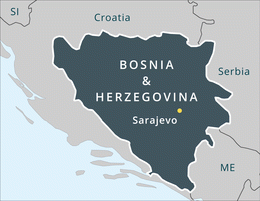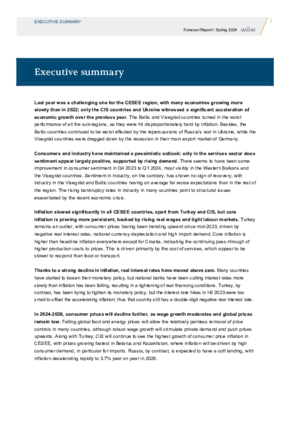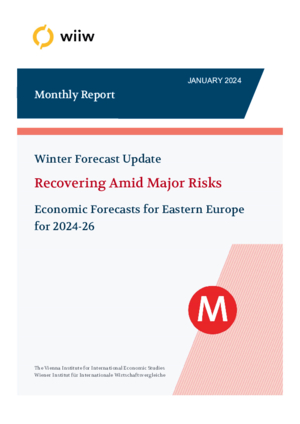Bosnia and Herzegovina

| FORECAST* | ||||||
|---|---|---|---|---|---|---|
| Main Economic Indicators | 2021 | 2022 | 2023 | 2024 | 2025 | 2026 |
| Population, 1000 persons | 3453 | 3434 | 3410 | . | . | . |
| GDP, real change in % | 7.4 | 4.2 | 1.7 | 2.5 | 2.9 | 3.4 |
| GDP per capita (EUR at PPP) | 10990 | 12270 | 12780 | . | . | . |
| Gross industrial production, real change in % | 9.8 | 0.9 | -3.9 | . | . | . |
| Unemployment rate - LFS, in %, average | 17.4 | 15.4 | 13.2 | 12.9 | 12.7 | 12.4 |
| Average gross monthly wages, EUR | 788 | 881 | 995 | . | . | . |
| Consumer prices, % p.a. | 2.0 | 14.0 | 6.1 | 2.8 | 2.5 | 2.0 |
| Fiscal balance in % of GDP | -0.3 | -0.4 | 1.0 | -0.5 | -0.7 | -1.0 |
| Public debt in % of GDP | 33.9 | 29.3 | 26.9 | . | . | . |
| Current account in % of GDP | -1.8 | -4.3 | -2.8 | -3.6 | -3.1 | -3.0 |
| FDI inflow, EUR m | 610 | 754 | 874 | . | . | . |
| Gross external debt in % of GDP | 57.2 | 51.4 | 48.9 | . | . | . |
Basic data are continuously updated.
* Forecasts are changed beginning of January, April, July and November.
See Press Conferences.
Executive summary
Olga Pindyuk
in: The Crisis is Over, but its Scarring Effects are Hindering Recovery
wiiw Forecast Report No. Spring 2024, April 2024 , pp. I-VII
Details
Monthly Report No. 1/2024
Vasily Astrov, Alexandra Bykova, Rumen Dobrinsky, Selena Duraković, Meryem Gökten, Richard Grieveson, Doris Hanzl-Weiss, Gabor Hunya, Branimir Jovanović, Niko Korpar, Sebastian Leitner, Isilda Mara, Olga Pindyuk, Sandor Richter, Marko Sošić, Bernd Christoph Ströhm, Maryna Tverdostup and Adam Żurawski
wiiw Monthly Report No. 1, January 2024
50 pages including 5 Tables and 18 Figures

